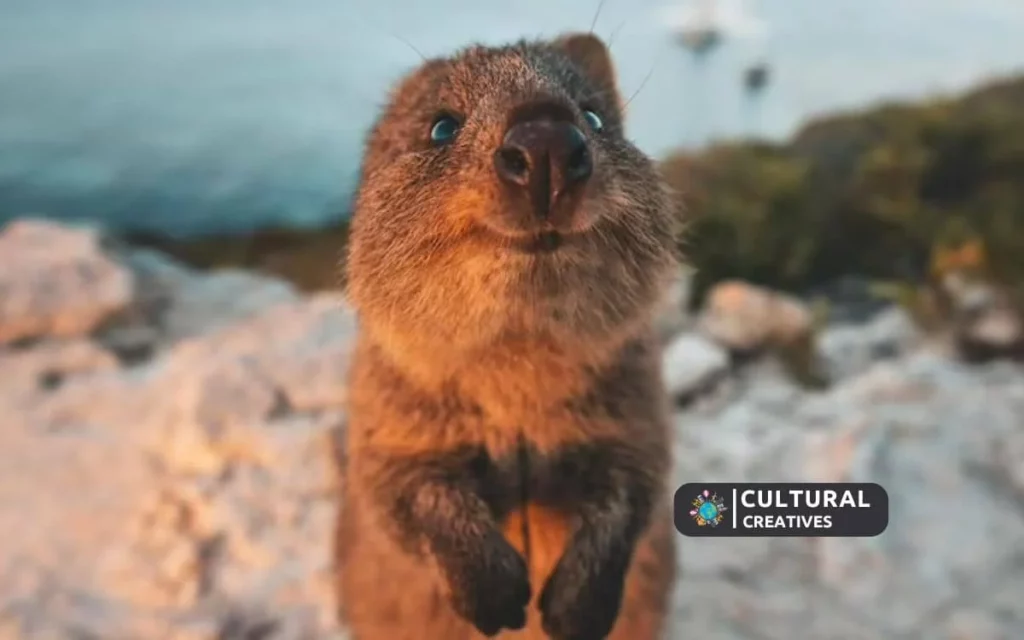There are an estimated 10,000-12,000 quokkas on Rottnest Island. This population makes the island the primary habitat for these small marsupials.
Rottnest Island, located off the coast of Western Australia, is renowned for its population of quokkas, small wallaby-like creatures that have become famous for their friendly nature and photogenic smiles. These adorable animals are a significant draw for tourists, contributing to the island’s reputation as a nature-lover’s paradise.
As the world’s happiest animal, quokkas have adapted to the island’s environment, thriving in the scrublands and woodlands. The island’s conservation efforts ensure quokkas enjoy a protected haven free from many predators, allowing visitors an up-close encounter with these unique Australian marsupials in their natural habitat.
Quokkas: Australia’s Adorable Marsupial
The quokka, a small, nocturnal marsupial native to Australia, has captured hearts worldwide. Known for their friendly demeanor and photogenic smiles, these creatures have become a symbol of Australia’s unique wildlife. Today, Rottnest Island near Perth is famous for its thriving quokka population. Let us uncover what makes these animals so special and why Rottnest Island provides the perfect habitat for them.
Unique Traits Of Quokkas
Quokkas are small marsupials, part of the macropod family, which includes kangaroos and wallabies. Their charming smiles and curiosity toward humans make them approachable and a fan favorite for visitors. With fur ranging from brown to grey, a petite build, and a tail for balance, they are well-adapted to their environment. Unique to quokkas:
- They can survive without fresh water for long periods.
- Their hind legs are powerful, aiding in swift movement.
- Pouch presence for carrying their young ones.
Habitat: Why They Love Rottnest Island
Rottnest Island offers an ideal habitat for quokkas. It’s free from predators, has a moderate climate, and provides abundant food sources. Here’s why:
| Feature | Benefit to Quokkas |
|---|---|
| No natural predators | Safe breeding grounds and red |
A Snapshot Of Rottnest Island
Hidden like a jewel in the Indian Ocean, Rottnest Island shines with natural beauty and a playful twist. Remarkably, it’s the only place where the happy marsupial, the quokka, thrives in the wild. Let’s peek into its world and uncover why this island is a haven for these adorable creatures.
Geography And Climate Conducive To Quokkas
The island’s unique geography and climate create the perfect home for quokkas. Rottnest Island boasts a mild climate, with cool winters and warm summers. These conditions mirror the quokka’s needs for a comfortable habitat. A brief overview of the island’s geography:
- Location: Off the coast of Western Australia
- Size: Around 19 square kilometers
- Topography: A mix of sandy beaches and rocky shores
- Vegetation: Lush bushland with small, freshwater sources
All these factors contribute to a thriving quokka population, which is believed to number around 10,000 to 12,000 individuals.
Rottnest Island As A Tourist Destination
Not only do quokkas love Rottnest Island, but travelers do too. This spot is a magnet for tourists from all corners of the globe. Key attractions include:
| Attraction | Description |
|---|---|
| Quokka Sightings | Watching and snapping selfies with the world’s happiest animal. |
| Beaches | Sunning on pristine sands by crystal-clear waters. |
| History Tours | Exploring cultural and wartime heritage sites. |
Tourism keeps the island buzzing and helps fund conservation efforts to protect its unique wildlife.
Population Dynamics Of Quokkas
The enchanting quokkas of Rottnest Island are a source of delight and curiosity to visitors. Understanding the quokka population dynamics is critical for their conservation. These small, nocturnal marsupials play a pivotal role in the island’s ecosystem.
Historic And Current Population Trends
Quokkas, once abundant across many regions, faced drastic population declines. On Rottnest Island, the story is different. Thanks to conservation efforts, the current trends are promising. Estimates suggest a steady rise in their numbers compared to historical data.
- Pre-1900s: Wide distribution in Western Australia.
- 1900s: Numbers shrank due to predators and habitat loss.
- Now: Rottnest Island’s population is a stronghold.
Methods Of Estimating Quokka Numbers
Experts use various methods to gauge the quokka population. These methods ensure accurate monitoring and help guide conservation actions.
| Method | Details |
|---|---|
| Direct Observation | Counting quokkas during set periods of the day. |
| Camera Traps | Automated photography captures quokkas, minimizing human disturbance. |
| Population Modeling | Using statistical models to estimate numbers based on available data. |
By pairing these methods with technology advancements, researchers can track quokka populations more precisely. This data is crucial for ongoing protection efforts.
Threats To Quokkas On Rottnest Island
The quokkas of Rottnest Island face several challenges to their survival. These friendly creatures are well-loved, but they are not without risks. Understanding these dangers helps in crafting measures to protect the iconic marsupials of this beautiful island.
Natural Predators And Human Impact
Quokkas have few natural predators on Rottnest Island.
- Birds of prey may target juvenile quokkas.
- Introduced species, like foxes and cats, pose a significant threat.
Human activity also impacts these creatures.
- Land development reduces habitat space.
- Vehicle collisions are a constant danger.
- Feeding by tourists, although well-intentioned, can lead to poor health.
Disease And Climate Change Effects
Diseases can spread quickly among quokkas.
- Phytophthora fungus affects vegetation, reducing food sources.
- Infections like salmonella also threaten their population.
Climate change poses long-term risks.
- Altered weather patterns may disrupt their habitat.
- Increased bushfires can destroy nesting grounds.
- Lack of fresh water sources challenges their survival.
Conservation Efforts
The quokkas of Rottnest Island are more than just adorable marsupials – they’re a symbol of successful conservation. Efforts to protect the quokka population have become a top priority. This ensures these creatures thrive for generations. Let’s delve into the measures keeping these animals safe and flourishing on their island home.
Local And National Protection Policies
Local and national policies play a crucial role in quokka conservation. The government lists quokkas as a protected species. This means it is illegal to harm or disturb them.
- The Rottnest Island Authority oversees conservation.
- They enforce rules that keep quokkas safe from human interference.
- Policies ensure habitat preservation and careful tourism management.
The combination of these policies aids in maintaining a healthy quokka population. Strict rules guide human interaction, holding visitors accountable for their actions.
Role Of Research And Monitoring
Research and monitoring provide insights into the needs of the quokka population. Biologists track quokka numbers to understand trends and threats. These activities inform management strategies and help to prevent decline.
- Researchers conduct regular population counts.
- Scientists study quokka health and breeding patterns.
- Technology like GPS tracking monitors quokka movements.
Continuous monitoring ensures responses to quokka needs are swift and effective. These efforts are vital for the long-term survival of Rottnest Island’s quokkas.
Human Interaction With Quokkas
Quokkas are small, adorable creatures native to Rottnest Island. The island is famous for its friendly quokka population. Tourists often visit to snap selfies with these sociable animals. It’s important to understand how to interact with quokkas. Proper conduct ensures these critters stay safe and happy.
Tourism And Animal Welfare
Rottnest Island sees thousands of visitors each year. Quokkas, often called the world’s happiest animals, are a major draw. With tourism comes the need for sustainable practices. This ensures quokka populations thrive in harmony with human visitors. Tourists must respect wildlife. They should never feed or touch the quokkas.
- Use trash bins to keep the island clean.
- Keep a respectful distance from these wild animals.
- Avoid leaving food that can harm quokkas.
Observing quokkas from afar prevents stress and maintains their natural behavior.
Regulations For Visitor Conduct
The government sets rules for interacting with Rottnest Island’s quokkas. Signs around the island remind visitors of these guidelines. Fines are in place for those who ignore these rules. A table below lists key regulations:
| Behavior | Regulation |
|---|---|
| Feeding Quokkas | Strictly Prohibited |
| Touching Quokkas | Not Allowed |
| Photography with Quokkas | Allowed at a Distance |
Remember! Wildlife protection laws on Rottnest Island are strict. Touching or feeding quokkas can harm them. Your behavior affects their well-being. Always follow the rules to protect these friendly marsupials.
The Role Of Quokkas In Biodiversity
Radiating outwards from the soft beaches and rugged coastlines of Rottnest Island, lives a keen-eyed marsupial, the quokka. This small relative of kangaroos and wallabies has become synonymous with the island. Deeply embedded in the ecosystem, quokkas play a pivotal role in maintaining the island’s biodiversity. Their presence ensures a balanced and thriving natural habitat.
Quokkas As A Keystone Species
A keystone species acts as a vital cog within an ecosystem, often shaping the environment and influencing the lives of other organisms. Quokkas are such creatures on Rottnest Island. Their foraging habits help in spreading native plant seeds, ensuring diverse vegetation grows. This vegetation supports myriad other species, from insects to birds to other small mammals.
Interdependency In The Island’s Ecosystem
On Rottnest Island, life thrives on interdependency. The quokka’s relationship with its habitat is a beautiful dance of give and take. Through their digging, quokkas aerate the soil—improving its health. This soil supports plants that in turn nourish the quokkas. A delicate balance persists, one that highlights the critical nature of every living piece within this ecosystem.
| Element | Role in Ecosystem | Impact on Quokkas |
|---|---|---|
| Soil Aeration | Promotes plant growth | Ample food source |
| Seed Dispersion | Encourages biodiversity | Varied habitats |
| Vegetation Health | Attracts other species | Richer environment |
- Quokkas contribute to the health of the island.
- Their actions benefit countless species and eco-processes.
- Quokkas aid in diverse plant growth.
- They play a part in controlling the insect population.
- Quokkas indirectly affect bird life.
Rottnest’s Future
The future of Rottnest Island shines bright, anchored in sustainability and respect for its unique ecosystem. Home to the adorable quokka, the island’s management balances growth with nature. Specific initiatives aim to ensure that both the quokka population and tourism can thrive harmoniously.
Projected Population Growth
Quokkas, beloved worldwide, face a future shaped by careful study and management. Scientists predict a stable population if current conservation efforts continue.
| Year | Expected Quokka Numbers |
|---|---|
| 2025 | Over 12,000 |
| 2030 | Steady growth |
| 2040 | Healthy population |
Future projections are based on current data and conservation practices.
Balancing Conservation And Tourism Interests
Protecting quokkas and embracing visitors requires balance. Rottnest Island takes this seriously.
- Limited visitor numbers to reduce impact.
- Eco-friendly tours that educate while entertaining.
- Research-driven policies guiding island use.
- Investment in quokka habitats and health.
The island’s future hedges on blending preservation with visitor experiences. Efforts like these ensure quokkas thrive and tourists can witness these remarkable creatures responsibly.
Conclusion
Wrapping up, Rottnest Island remains a sanctuary for the charming quokkas. With an estimated population around 10,000, these marsupials thrive in this habitat. It’s crucial to protect their environment, ensuring quokka numbers stay healthy. Visit responsibly to witness this unique species without disrupting their home.


